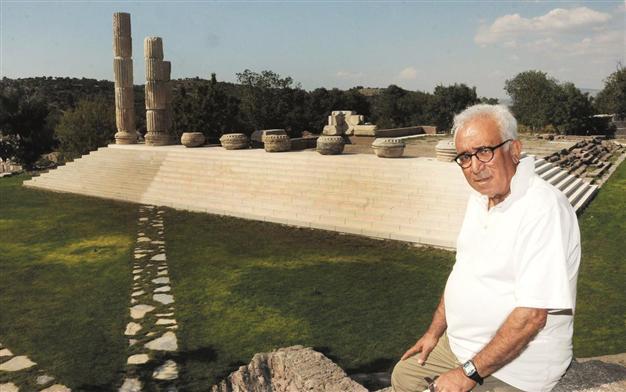Historical Apollon temple arises from rendering plant
ÇANAKKALE - Doğan News Agency

Professor Coşkun Özgünel retired in 2008 but he has been continuing excavations in Smintheus Temple.
2,000-year-old Apollon Smintheus Temple, which was under a rendering plant in the northwestern province of Çanakkale’s Ayvacık district, has been re-discovered after long-term archaeological efforts.Professor Coşkun Özgünel, who initiated the excavations in 1980 in the Gülpınar village on behalf of the Culture and Tourism Ministry Cultural Heritage and Museums General Directorate, has spent 35 years of his life dedicated to the Apollon Smintheus Temple. Even though he retired in 2008, Özgünel continued excavations with the goal to revive the southern façade of the temple, which has been looted since the 18th century, using the original tools in hand.
He said when they started the excavations, there was a rendering plant and a dairy firm on the temple, a hovel for laborers next to it and was surrounded by storehouses keeping the olive sacks. One year after the Culture Ministry expropriated this area, in 1982 they started to remove the rendering plant, which had been constructed on the temple, said Özgünel, adding they had seen a great damage in the region. “We found most of the pieces of the temple in Gülpınar and in the Tuzla lowlands and gathered these pieces,” he added.
The professor said when they had come to the area for excavations, there was no sign of the Apollon Smintheus.
“Pieces of columns were massed in a place in the temple’s area. Everywhere was a garden. Water pools were constructed; people were watering their gardens through these pools. The name of this area had been ‘Bahçeleriçi’ [inside the gardens] since 1866. There was a rendering plant on the temple. The owner of the plant made use of this area. He built storehouses, as well as channels to discharge the waste from olives. We found the temple among all of these things. They were expropriated one by one. The structure that we organized as a depot museum in the entrance of the temple was another rendering plant. There was a vast layer of earth on the temple. Using the original pieces, we began building its southwestern side. Pullan, who made the first excavations here in 1866, began reconstructing this place and described all of these things,” he said.
“We are following his traces and rebuilding this temple. We succeeded in drawing the temple’s southern entrance’s façade. Now we are continuing the restoration of this façade using original pieces. We have 80 percent of these original pieces.”
The best preserved chalcolithic center
Listing what they had found during the 35 years of excavations, Özgünel said they had discovered a temple from a rendering plant, a depot museum from another rendering temple, a bath complex with a gymnasium, a Roman villa, a bath to the Roman villa, water depots and the most important and best preserved chalcolithic center in northwestern Anatolia, dating back to 4500 B.C.
“But we have many more things to do,” the professor said. “These restorations will continue for centuries. The biggest holy area, which served the Alexandria Troas, along with Troy, will be completely unearthed. We will first finish the restorations in the temple. Then, we will plan the environmental arrangement.
We covered the temple’s long and narrow parts with grass. When the restoration is done, other façades will be covered with grass and small decorative plants. We also want to cover
Gülpınar and open it to visitors as the most important chalcolithic center in northwestern Anatolia. We also plan to restore the other rendering plant, which we expropriated two years ago, and turn it into a museum. I want to leave the excavations here to a young person and follow them from a distance with pleasure. This is my biggest wish.”
















